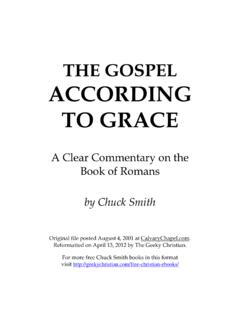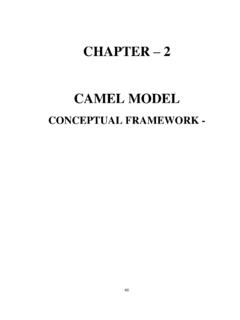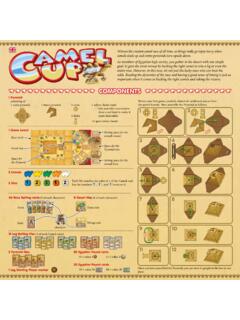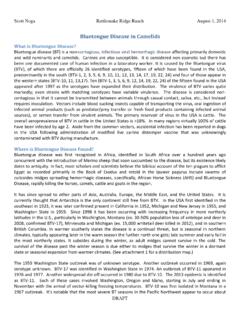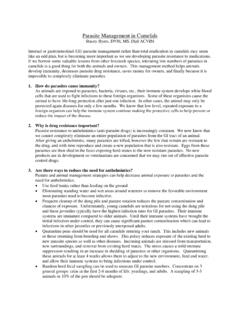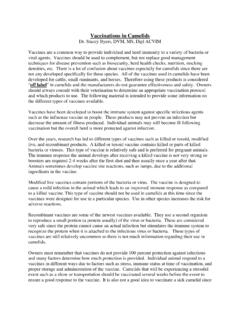Transcription of The Domestication of the Camel in the Ancient Near East
1 1 The Domestication of the Camel in the Ancient Near East (Domestic camels on the Black Obelisk of Shalmaneser III, British Museum) Introduction The single humped Camel , Camelus dromedarius, and the double humped Camel , Camelus bactrianus, have been important for use as a draft animal, saddle animal, food source, and even textile source in the Near East for thousands of years. The Dromedary is the most common in the Near East, although both species have been in use by humans in the region for a long period of time. Although many claim there is a consensus within archaeological circles, in reality, scholars debate exactly when the Camel was first domesticated in the Near East for any purpose.
2 The theories range from as late as the 9th century to as early as the beginning of the 3rd millennium , depending on the availability of data, interpretation of data, and personal opinions, leaving quite a wide range of years in dispute. 2 The Domestication debate impacts several instances of camels being used as beasts of burden prior to the 12th century within the Old Testament books of Genesis, Exodus, Judges, and Job. The word Camel ( ) is used in a domesticated sense 22 times in Genesis (12:16, 20:10-64, etc.), once in Exodus (9:3), 4 times in Judges (6:5, 7:12, 8:21, 8:26) and 3 times in Job (chapters 1 and 42).
3 1 It is clear that in these books camels are used in a domesticated sense, and often as beasts of Typically, Ancient Near Eastern scholars such as Donald Redford, Israel Finkelstein, and William Albright, subscribe to as late as a 9th century view, or at earliest the end of the 12th century Donald Redford, when discussing a reference concerning Camel Domestication in the book of Judges, writes anachronisms do indeed do not appear in the Near East as domesticated beasts of burden until the ninth century 3 He refers to some of the aforementioned scholars, among others, and their writings concerning Camel Domestication as fellow proponents of this 9th century view.
4 Finkelstein and Silbermann state, We now know through archaeological research that camels were not domesticated as beasts of burden earlier than the late second millennium and were not widely used in that capacity in the Ancient Near East until well after 1000 1 Although the date for the setting of Job is debatable, it is plausible to place it in a Middle Bronze context similar to Abraham, Isaac, and Jacob. There are several similarities in the texts, such as life over 140 years, wealth measured in livestock, the patriarch as the priest of the family, and no mention of the nation Israel or the Torah.
5 2 In Egypt, Abraham is given a gift of servants and several types of domesticated animals, including sheep and oxen and female donkeys and camels (Genesis 12:16) and later one of his servants made the camels kneel down outside the city by the well of water at evening time (Genesis 24:11). Jacob used camels for transportation, putting his children and his wives upon camels (Genesis 31:17) and to own milking camels and their colts (Genesis 32:15). The camels in Exodus were part of the various domesticated animals of the Egyptians (Exodus 9:3), while in Judges camels are domesticated beasts of the Midianites and Amalekites (7:12).
6 The book of Job claims that the protagonist possessed camels in the context of other domesticated animals (Job 1:3). 3 Redford, Donald B., 1992, Egypt, Canaan, and Israel in Ancient Times, Princeton University Press, Princeton, New Jersey, 277. 3 BCE. 4 This stance is similar to Redford s, but allowing for the possibility of a few centuries earlier on a much smaller scale. It is interesting to note that although Redford claims camels were not domesticated in the Ancient Near East until the 9th century, and Finkelstein and Silberman say they were not widely used until well after 1000 , by the middle of the ninth century cavalries were obviously well established, since at the Battle of Qarqar Shalmaneser III faced many men on horseback (and some on the backs of camels ).
7 5 Albright writes that our oldest certain evidence for the Domestication of the Camel cannot antedate the end of the twelfth century 6 His argument was based on his belief that the oldest published reference to the Camel dates from the eleventh century , referring to an Assyrian This text is the Broken Obelisk, probably from the reign of Ashur-bel-kala (1074-1056 ), but some of the reports on it may refer to the time of Tiglath Pileser I (1115-1077 ). The obelisk resides in the British museum, and the inscription mentions the breeding of Bactrian camels .
8 As a result, these are the dates assumed throughout most of the literature, and thus the general consensus became that there were no domesticated camels in the Ancient Near East prior to the Iron Age. As an answer to Ancient texts that claim the Bronze Age use of domesticated camels , an explanation offered is the later scribal substitution of Camel for some other pack animal such as a donkey. This applies to Hebrew texts such as the books of Genesis, Exodus, Judges, and Job which claim the domesticated use of camels prior to the Iron Age. Yet, concerning substitution of Camel for another animal, Millard argues that a later 4 Finkelstein, Israel and Silberman, Neil Asher, 2001, The Bible Unearthed, Free Press: New York, 37.
9 5 Drews, Robert, 1993, The End of the Bronze Age, Princeton University Press, Princeton, New Jersey, 165. 6 Albright, , 1951, The Archaeology of Palestine, Penguin Books, Harmondsworth, Middlesex, 207. 7 Ibid, 206. 4 writer making modifications in the text in an attempt to emphasize the wealth of the patriarchs would not substitute Camel but instead horse , since horses were expensive and valuable during the Iron This is a plausible assertion that demonstrates a textual emendation from horse or another animal to Camel would be highly unlikely. Further, there are cuneiform texts which suggest the use of domesticated camels in the Bronze Age that could not be attributed to later scribal emendations or copying error.
10 Still, the general consensus by Ancient Near Eastern scholars over the last several decades has been that camels were not domesticated in the area until the Iron Age. camels as Imports from the East Assuming that those who subscribe to a 12th century or later view for the Domestication of the Camel in the Ancient Near East are correct, there is still the possibility that domesticated camels existed in the Near East before the 12th century as imports from the East, instead of being locally domesticated. Daniel Potts presents this possibility, suggesting that camels were domesticated in the area of eastern Iran long before the 12th century , and brought west for Therefore, domesticated camels may have been in use in the Near East prior to the 12th century and the beginning of the Iron Age through trade, and the people of the Near East may soon have learned to domesticate their own local camels .
